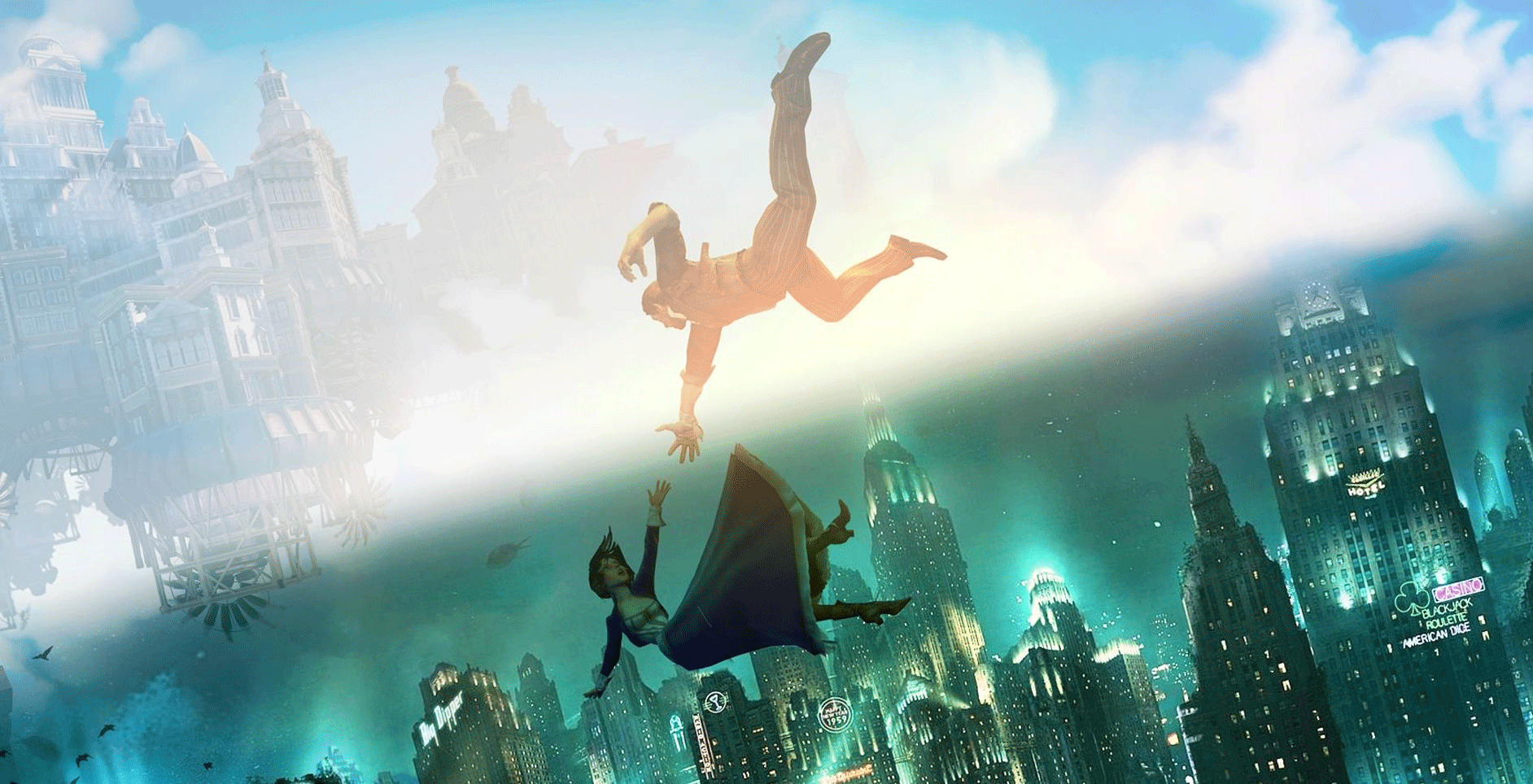BioShock as a franchise takes inspiration from those that came before – System Shock, Thief and Deus Ex are just some of the key franchises that contribute in some way, shape or form to BioShock. While BioShock games are nowhere near as involved or complex at a systems level as its predecessors, it’s an almost perfect case study on how to streamline something without dumbing it down. At first appearance a shooter, in actuality, the game is a veritable sandbox. There’s a set of systems in place and it’s up to players to learn and exploit these systems to create their approach. You can shoot someone, you can hack a turret to take them down instead, you can get them to call a security bot against you and then turn that against them too. You can use powers to freeze, burn, throw, distract. You can do whatever you want.
BioShock: The Collection brings together all three of the BioShock games together into a single package. Each has their respective expansions included – BioShock has all the extras that were added into the belated Playstation 3 version. BioShock 2 has the Protector Trials challenge mode and critically acclaimed Minerva’s Den single player expansion. BioShock: Infinite brings with it the Clash in the Clouds arena battle mode and the very essential Burial At Sea epilogue chapters. That’s a lot of content and more importantly, a lot of quality content and because of this BioShock: The Collection represents an absolutely fantastic value proposition for players. But a collection is only as strong as the games within it, and some of these games are bordering on becoming a decade old. The original BioShock was released in 2007 and is possibly what many fans would consider to be the greatest in the franchise. It’s a tenser, psychologically overwhelming affair that takes players to the dark depths of Rapture, a city underneath the sea. BioShock to this day remains the more horror orientated of the three games with an emphasis on dark and foreboding set pieces than all out battles. While there are some things that are starting to date, they’re largely only cosmetic things like fonts and user interfaces. As a whole, the game still stands up today and is an excellent entry point into the mind-bending BioShock universe.
But a collection is only as strong as the games within it, and some of these games are bordering on becoming a decade old. The original BioShock was released in 2007 and is possibly what many fans would consider to be the greatest in the franchise. It’s a tenser, psychologically overwhelming affair that takes players to the dark depths of Rapture, a city underneath the sea. BioShock to this day remains the more horror orientated of the three games with an emphasis on dark and foreboding set pieces than all out battles. While there are some things that are starting to date, they’re largely only cosmetic things like fonts and user interfaces. As a whole, the game still stands up today and is an excellent entry point into the mind-bending BioShock universe.
BioShock 2 shook things up a bit. Designed and developed by a different team, it puts you in the role of one of the most powerful enemies from the first game – the Big Daddy. At the time, BioShock 2 wasn’t really a sequel people were gunning for and is probably the most underrated in the franchise. It’s a retread of the city of Rapture, but it’s a story from an entirely new perspective – a warmer, more character driven story. The fact that you’re playing as a Big Daddy offers some interesting gameplay mechanics – though ultimately nothing that is revolutionary, instead iterative. In fact, BioShock 2 paints another picture of Rapture and the BioShock formula, but not one that you’ll even know you wanted until you’ve experienced. It’s a solid experience and its expansion, Minerva’s Den, is one of the strongest points of the entire series.
BioShock: Infinite is easily the highest profile of the series. Developed by the team who brought us the original game, it takes events out of the sea and into the city in the clouds, Columbia. With this shift came a major shift in tone. Infinite is first and foremost a shooter with a focus on flashy set pieces more so than the cunning and stressful moments in BioShock. A controversial entry in the series that deals (but at the same time, doesn’t really) with tried and true topics like religion and taboo topics such as racism and classism in Americana. BioShock Infinite ruffled lots of feathers for lots of reasons – whether all the violence was necessary, whether the themes were explored and whether it was better than the games before it. It’s an amazing game with an amazingly twisted story, but a much more divisive one. There’s not much to say about the BioShock games that I haven’t already. They’re all driven by genuinely alluring stories. They’re all really approachable – namely due to a mix of difficulty levels and the design catering to different catering styles. And even more importantly, they still stand up today. While there are some design questions that to this day remain questionable (for example, there’s a majorly disappointing boss battle in one game, an anticlimactic finale in another and a notable absence of a boss battle in another) but the games as a whole still flow really well. They control well, they flow well, they’re all really well paced and they look better than ever.
There’s not much to say about the BioShock games that I haven’t already. They’re all driven by genuinely alluring stories. They’re all really approachable – namely due to a mix of difficulty levels and the design catering to different catering styles. And even more importantly, they still stand up today. While there are some design questions that to this day remain questionable (for example, there’s a majorly disappointing boss battle in one game, an anticlimactic finale in another and a notable absence of a boss battle in another) but the games as a whole still flow really well. They control well, they flow well, they’re all really well paced and they look better than ever.
And that’s where BioShock: The Collection really shines. The developers have gone back through each game and made a conscious effort to make sure that all the games stand up against their contemporaries on the new consoles. Some of the improvements, like a solid frame rate of 60 frames per second, are most probably already enjoyed by most PC players today. But those who have experienced the games on console only are in for a treat. Not only is the image smooth but it speeds the combat up, particularly raising the already frenetic combat of Infinite to another level. All three games run great, though the more modern visuals of Infinite did suffer some bouts of slowdown. This isn’t where the visual improvements ended, though. The team have gone through and touched up various areas in the games to add more depth or detail to the environments. There are more notable weather effects, better-looking water and a much needed and much-improved lighting system. There are some other minor details added – barrels now leak wine and Big Daddys leak….something when peppering them with bullets during intense battles. The team who handled the remaster, Blind Squirrel Games, have also improved the look of the game outside of its boundaries, adding more marine life like jellyfish and starfish. Make no mistakes, every game in BioShock: The Collection could easily hold their ground against many of their contemporaries today, a testament to the astonishingly robust art direction.
This isn’t where the visual improvements ended, though. The team have gone through and touched up various areas in the games to add more depth or detail to the environments. There are more notable weather effects, better-looking water and a much needed and much-improved lighting system. There are some other minor details added – barrels now leak wine and Big Daddys leak….something when peppering them with bullets during intense battles. The team who handled the remaster, Blind Squirrel Games, have also improved the look of the game outside of its boundaries, adding more marine life like jellyfish and starfish. Make no mistakes, every game in BioShock: The Collection could easily hold their ground against many of their contemporaries today, a testament to the astonishingly robust art direction.
Players who have already had their fill of Rapture and Columbia will be pleased to hear that there is a reasonably major inclusion in The Collection that has never been seen before. Finding reels of film in the games unlocks interviews with Ken Levine and Shawn Robertson, the key men behind the franchise. The footage was shot especially for the collection and offers some amazing insight into the development of the franchise. Finding objects in the game unlocks the videos to be viewed there, on the spot, or in a menu later. The videos themselves are shot well, but are compressed and presented at a lower frame rate which is quite jarring at first. Disappointingly, there’s no controls on these videos and you can only watch them or quit them. There’s no pausing or rewinding. None the less, they’re an amazing inclusion that flesh out the development history of the games and one that fans will no doubt appreciate.
CONCLUSION
BioShock: The Collection is an amazing effort. BioShock 1, 2 and Infinite all look their very best and plenty of effort has gone into making each of the games stand up to today’s lofty visual standards. Effects are more believable, gameplay is smoother and the narrative is just as intriguing as it was all those years ago.
The extra content is a great touch and one that’ll hit a nerve with those who have played BioShock to death, picking the minds of some of the most talented guys in the industry. But this content is implemented a little bit carelessly. It’s hard to complain about it, since this feature was shot just for this collection, but it’s the only thorn on what is an otherwise beautiful, flourishing rose. BioShock: The Collection is absolutely a remaster you have to play, new to the series or otherwise.



